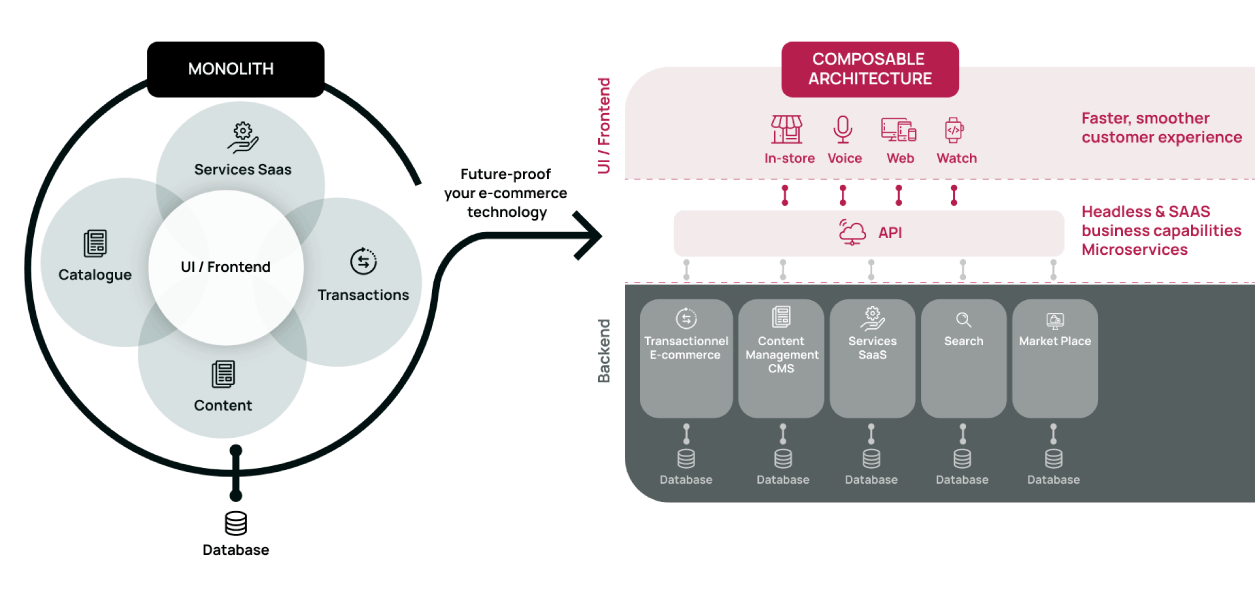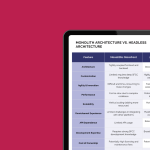Is your Salesforce Commerce Cloud storefront holding you back from achieving peak performance and a truly personalized customer experience? SFCC users face various challenges, including limitations in flexibility, innovation, and customization due to the monolithic nature of the platform. These constraints can hinder businesses from adapting quickly to market changes and providing tailored experiences to customers.
Improve your SFCC Experience with Headless Commerce. Headless commerce offers a solution by decoupling the frontend from the backend in your Commerce Cloud application. This approach allows for greater agility in building personalized customer experiences across multiple channels by enabling communication between the frontend and backend through APIs. In contrast to traditional monolithic platforms, headless commerce provides businesses with the flexibility to innovate faster and deliver seamless customer experiences.
Taking your Salesforce Commerce Cloud Headless
Salesforce Commerce Cloud is headless-enabled, allowing users to leverage headless commerce benefits and the ability to choose any compatible frontend. This integration paves the way for a broader range of options, enabling developers to customize key components and functions for enhanced flexibility and speed of change. Salesforce provides various ways to go headless with SFCC, including composing a custom tech stack tailored to specific business needs. SFCC’s Managed Runtime provides an app server combining React, Node.js, and Express framework supported by edge services like a web application firewall and CDN for optimized performance.
By adopting headless commerce with SFCC, businesses can enhance user experience, improve conversion rates, and achieve greater technological freedom. This approach allows for seamless integration with third-party applications, personalized customer experiences, improved site performance, and cost-effective development. The combination of headless architecture with tools like frontend-as-a-service (headless frontend) encourage the creation of innovative product-based experiences across various channels while maintaining flexibility and scalability.
For SFCC users looking to overcome the limitations of traditional monolithic platforms, transitioning to a headless commerce approach presents a promising solution that can drive growth, innovation, and customer satisfaction.
Benefits of Headless Commerce for SFCC Users
- Flexibility and Faster Development:
- Decoupling the frontend and backend in headless commerce allows for independent updates. This facilitates faster development cycles and greater agility in responding to market demands.
- Headless commerce enables SFCC users to leverage a “best-of-breed tech stack”. Incorporating solutions like React and Vue.js for front-end development enhances flexibility and time-to-market.
- With headless commerce, access benefits such as: seamless integrations with various systems, speed and agility in implementing changes, cost savings through consolidation, improved customer experiences, and a competitive edge.
“Salesforce found that 69% of brands report headless commerce enables them to expand to new channels and touchpoints faster” – Salesforce
2. Improved Performance:
-
- Headless architectures enhance website performance by enabling faster load times and delivering a smoother user experience.
- These faster loading times can lead to better search engine rankings, improving visibility and attracting more organic traffic to your store.
- By leveraging headless commerce, an enhanced web performance will drive conversion rates, streamline integrations, and provide a more engaging and personalized customer experience
3. Enhanced Personalization:
-
- Headless commerce facilitates personalized customer experiences. Advanced customization options and tailored content delivery allow businesses to create unique and engaging interactions with their customers.
- An example of which being the capacity to integrate tools into your e-commerce stack. For example, AI search to recommend products based on past purchases or browsing behavior, providing relevant suggestions that increase conversions.
- By leveraging headless commerce, SFCC users can not only enhance personalization but also improve customer engagement and drive loyalty with tailored experiences.
4. Mobile-First Approach:
-
- Mobile optimization is crucial today. Headless commerce empowers SFCC users to deliver seamless experiences across various devices, emphasizing a mobile-first approach.
- Headless commerce enables the creation of Progressive Web Apps (PWAs) that offer app-like experiences on mobile devices. PWAs leverage modern web technologies to provide: fast loading times, offline access, push notifications, and responsive designs for optimal user experiences.
Monolith vs. Headless Architecture Comparison
While monolithic architectures offer simplicity and cost-effectiveness, headless commerce provides greater scalability, flexibility, performance, and ease of customization for SFCC users looking to enhance their digital commerce experiences.
The benefits highlighted above are but a few, dive into the comparison below the diagram, or download the comparison chart here.

Feature |
Monolithic Architecture |
Headless Commerce |
| Architecture | Monolithic systems have tightly integrated front-end and back-end layers within a single codebase, offering simplicity but limiting flexibility and scalability. | Headless commerce separates the front-end presentation layer from the back-end logic layer, offering greater flexibility and scalability compared to monolithic systems. |
| Performance | Monolithic architectures are less scalable than headless solutions. Changes to one component can impact the entire system, affecting performance and user experience. | Headless commerce solutions load faster due to decoupling. The backend generates the website structure during the first access, leading to better performance and user experience. |
| Flexibility | Monolithic systems are less flexible than headless architectures. All components are built on a single technology stack, making it challenging to adapt to changing needs. | Headless commerce allows for easy modifications with best-of-breed solutions. Tailor your tech stack to specific requirements and easily adapt to evolving needs. |
| Maintainability & evolutivity | Monolithic architectures can be more difficult to maintain as changes to one component can have ripple effects throughout the system, leading to complexities and potential issues. | Headless platforms enable true omnichannel order fulfillment, meeting the demand for flexible options like buy online pickup in-store (BOPIS). |

Monolith vs. Headless Commerce Comparison Chart
Embrace the future of e-commerce with headless commerce
SFCC’s monolithic storefront offers a familiar environment but may struggle with agility and customization. Transitioning to a headless commerce approach with Salesforce Commerce Cloud (SFCC) can significantly transform your e-commerce operations. By decoupling the frontend from the backend and embracing a modern tech stack, SFCC users can unlock a plethora of benefits, including enhanced flexibility, improved performance, personalized customer experiences, and a mobile-first approach.
As you contemplate the next steps for your e-commerce platform, we encourage you to carefully consider your specific needs and resources. Delve deeper into the implementation process, and discover how a headless architecture can revolutionize your SFCC experience in our upcoming articles. We’ll provide actionable insights and practical tips on implementing headless commerce solutions tailored specifically for SFCC users.

Up next:
